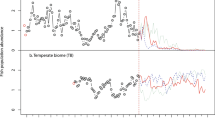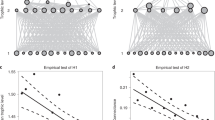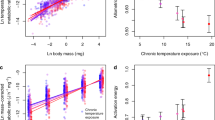Abstract
That species’ biological rates including metabolism, growth and feeding scale with temperature is well established from warming experiments1. The interactive influence of these changes on population dynamics, however, remains uncertain. As a result, uncertainty about ecological stability in response under warming remains correspondingly high. In previous studies, severe consumer extinction waves in warmed microcosms2 were explained in terms of warming-induced destabilization of population oscillations3. Here, we show that warming stabilizes predator–prey dynamics at the risk of predator extinction. Our results are based on meta-analyses of a global database of temperature effects on metabolic and feeding rates and maximum population size that includes species of different phylogenetic groups and ecosystem types. To unravel population-level consequences we parameterized a bioenergetic predator–prey model4 and simulated warming effects within ecological, non-evolutionary timescales. In contrast to previous studies3, we find that warming stabilized population oscillations up to a threshold temperature, which is true for most of the possible parameter combinations. Beyond the threshold level, warming caused predator extinction due to starvation. Predictions were tested in a microbial predator–prey system. Together, our results indicate a major change in how we expect climate change to alter natural ecosystems: warming should increase population stability while undermining species diversity.
This is a preview of subscription content, access via your institution
Access options
Subscribe to this journal
Receive 12 print issues and online access
$209.00 per year
only $17.42 per issue
Buy this article
- Purchase on Springer Link
- Instant access to full article PDF
Prices may be subject to local taxes which are calculated during checkout




Similar content being viewed by others
References
Brown, J. H., Gillooly, J. F., Allen, A. P., Savage, V. M. & West, G. B. Toward a metabolic theory of ecology. Ecology 85, 1771–1789 (2004).
Petchey, O. L., McPhearson, P. T., Casey, T. M. & Morin, P. J. Environmental warming alters food-web structure and ecosystem function. Nature 402, 69–72 (1999).
Vasseur, D. A. & McCann, K. S. A mechanistic approach for modeling temperature-dependent consumer-resource dynamics. Am. Nat. 166, 184–198 (2005).
Otto, S. B., Rall, B. C. & Brose, U. Allometric degree distributions facilitate food-web stability. Nature 450, 1226–1229 (2007).
Parmesan, C. Ecological and evolutionary responses to recent climate change. Annu. Rev. Ecol. Evol. Syst. 37, 637–669 (2006).
IPCC Climate Change 2007: The Physical Science Basis (eds Solomon, S. et al.) (Cambridge Univ. Press, 2007).
Parmesan, C. & Yohe, G. A globally coherent fingerprint of climate change impacts across natural systems. Nature 421, 37–42 (2003).
Thomas, C. D. et al. Biodiversity conservation—Uncertainty in predictions of extinction risk—Effects of changes in climate and land use—Climate change and extinction risk—Reply. Nature 430 http://dx.doi.org/10.1038/nature02719 (2004).
Thomas, C. D., Franco, A. M. A. & Hill, J. K. Range retractions and extinction in the face of climate warming. Trends Ecol. Evol. 21, 415–416 (2006).
Rall, B. C., Vucic-Pestic, O., Ehnes, R. B., Emmerson, M. & Brose, U. Temperature, predator–prey interaction strength and population stability. Glob. Change Biol. 16, 2145–2157 (2009).
Dell, A. I., Pawar, S. & Savage, V. M. Systematic variation in the temperature dependence of physiological and ecological traits. Proc. Natl Acad. Sci. USA 108, 10591–10596 (2011).
Savage, V., Gillooly, J., Brown, J., West, G. & Charnov, E. Effects of body size and temperature on population growth. Am. Nat. 163, 429–441 (2004).
Englund, G., Ohlund, G., Hein, C. L. & Diehl, S. Temperature dependence of the functional response. Ecol. Lett. 14, 914–921 (2011).
Rall, B. C. et al. Universal temperature and body-mass scaling of feeding rates. Phil. Trans. R. Soc. B 367, 2923–2934 (2012).
Boit, A., Martinez, N. D., Williams, R. J. & Gaedke, U. Mechanistic theory and modelling of complex food-web dynamics in Lake Constance. Ecol. Lett. 15, 594–602 (2012).
Schneider, F. D., Scheu, S. & Brose, U. Body mass constraints on feeding rates determine the consequences of predator loss. Ecol. Lett. 15, 436–443 (2012).
Yodzis, P. & Innes, S. Body size and consumer-resource dynamics. Am. Nat. 139, 1151–1175 (1992).
Brose, U., Williams, R. J. & Martinez, N. D. Allometric scaling enhances stability in complex food webs. Ecol. Lett. 9, 1228–1236 (2006).
Binzer, A., Guill, C., Brose, U. & Rall, B. C. The dynamics of food chains under climate change and nutrient enrichment. Phil. Trans. R. Soc. B 367, 2935–2944 (2012).
Rip, J. M. K. & McCann, K. S. Cross-ecosystem differences in stability and the principle of energy flux. Ecol. Lett. 14, 733–740 (2011).
Rosenzweig, M. L. Paradox of enrichment: destabilization of exploitation ecosystems in ecological time. Science 171, 385–387 (1971).
Brose, U. et al. Climate change in size-structured ecosystems.. Phil. Trans. R. Soc. B 367, 2903–2912 (2012).
Gillooly, J. F. B. Effects of size and temperature on metabolic rate. Science 293, 2248–2251 (2001).
Vucic-Pestic, O., Ehnes, R. B., Rall, B. C. & Brose, U. Warming up the system: Higher predator feeding rates but lower energetic efficiencies. Glob. Change Biol. 17, 1301–1310 (2011).
Pörtner, H. O. & Knust, R. Climate change affects marine fishes through the oxygen limitation of thermal tolerance. Science 315, 95–97 (2007).
Jousset, A., Lara, E., Wall, L. G. & Valverde, C. Secondary metabolites help biocontrol strain Pseudomonas fluorescens CHA0 to escape protozoan grazing. Appl. Environ. Microbiol. 72, 7083–7090 (2006).
Zuber, S. et al. GacS sensor domains pertinent to the regulation of exoproduct formation and to the biocontrol potential of Pseudomonas fluorescens CHAO. Mol. Plant. Microbe Interact. 16, 634–644 (2003).
Ehnes, R. B., Rall, B. C. & Brose, U. Phylogenetic grouping, curvature and metabolic scaling in terrestrial invertebrates. Ecol. Lett. 14, 993–1000 (2011).
White, C. R., Phillips, N. F. & Seymour, R. S. The scaling and temperature dependence of vertebrate metabolism. Biol. Lett. 2, 125–127 (2006).
Wood, S. N. Fast stable restricted maximum likelihood and marginal likelihood estimation of semiparametric generalized linear models. J. R. Stat. Soc. Ser. B 73, 3–36 (2011).
Kim, D. & Oh, H.-S. EMD: Empirical mode decomposition and Hilbert spectral analysis (2013); http://cran.us.r-project.org/web/packages/EMD/index.html
Pinheiro, J. et al. NLME: linear and nonlinear mixed effects models (2013); http://cran.us.r-project.org/web/packages/nlme/index.html
Zuur, A. F. Mixed Effects Models and Extensions in Ecology with R. (Springer, (2009).
Acknowledgements
The project received financial support from the Dorothea Schlözer Programme of Göttingen University. F.S. gratefully acknowledges financial support from the German Research Foundation (BR 2315/16-1). We thank C. Guill and A. Binzer for constructive ideas and suggestions during the coding process.
Author information
Authors and Affiliations
Contributions
K.E.F., U.B., B.C.R. and A.J. designed the microcosm experiment. K.E.F. conducted the experiments. Statistical procedures on time series and functional responses were carried out by B.C.R. and K.E.F. B.C.R analysed the database. F.S. wrote and analysed the bioenergetic model. All authors contributed to the manuscript.
Corresponding authors
Ethics declarations
Competing interests
The authors declare no competing financial interests.
Supplementary information
Rights and permissions
About this article
Cite this article
Fussmann, K., Schwarzmüller, F., Brose, U. et al. Ecological stability in response to warming. Nature Clim Change 4, 206–210 (2014). https://doi.org/10.1038/nclimate2134
Received:
Accepted:
Published:
Issue Date:
DOI: https://doi.org/10.1038/nclimate2134
This article is cited by
-
Relationships of temperature and biodiversity with stability of natural aquatic food webs
Nature Communications (2023)
-
Effects of substrate and elevated temperature on the growth and feeding efficiency of an invasive cyprinid fish, Tench (Tinca tinca)
Biological Invasions (2022)
-
Analysis on the stability of plankton in a food web with empirical organism body mass distribution
Environmental Science and Pollution Research (2022)
-
Alteration of coastal productivity and artisanal fisheries interact to affect a marine food web
Scientific Reports (2021)
-
Biodiversity of intertidal food webs in response to warming across latitudes
Nature Climate Change (2020)



